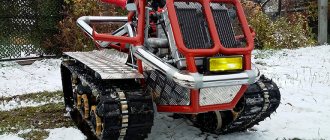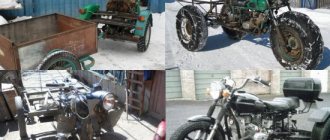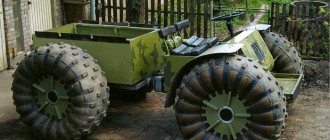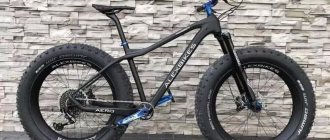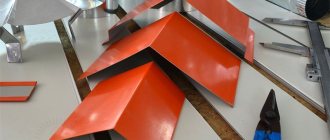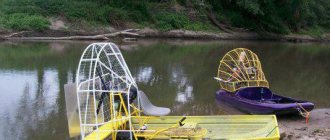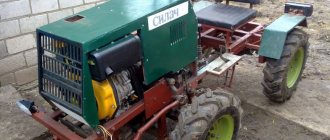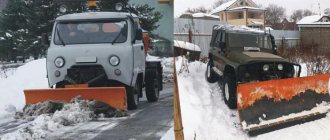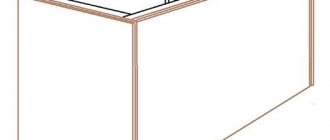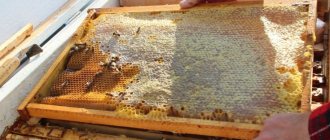Published:
21.06.2016
In rural areas, a common problem is the lack of roads. This problem is especially acute during winter, when even the usual crossings are covered with a layer of snow. To improve traffic even during such a period, you can make an all-terrain vehicle out of the Oka car on your own.
4x4 all-terrain vehicle "Kamazik-oka"
A 4x4 all-terrain vehicle based on OKI has a fairly conventional layout and is interesting for its simplicity and unpretentiousness. the author made a number of upgrades before bringing the all-terrain vehicle to its finished form. While building the all-terrain vehicle, the author encountered some problems that are useful to know for any novice all-terrain vehicle builder. It is to them that special attention will be paid in this article.
Materials and mechanisms used to create the all-terrain vehicle:
1) Wheels measuring 1200 by 508 2) racks from a VAZ 2110 3) hood from a VAZ 2101 4) profile pipe 50 by 50 5) axles from the Volga 6) transfer case from a Niva 7) axles from a Niva transfer case from a GAZ-69 9) gearbox from OKI.
a GAZ-69 9) gearbox from OKI.
Let's take a closer look at the problems the author encountered when building this all-terrain vehicle.
To begin with, a frame was made by hand from a profile pipe measuring 50 by 50.
Initially, axles from Niva were installed on the frame, but unfortunately the wheels and loads turned out to be too strong and the bridges could not withstand, namely, the satellites were torn, so it was decided to replace Niva axles with Volga axles.
But thanks to such wheels, the all-terrain vehicle has excellent maneuverability. A transfer case from Niva was also installed, which is also planned to be replaced with a transfer case from GAZ-69.
The radiator is installed, switching from 06 is done in a similar way:
The transfer case was replaced with a GAZ-69, racks from a VAZ 2110 were installed since the standard disc did not fit, so the springs had to be removed. At the same time, the suspension travel remained the same as on the Niva.
Replacing the transfer case from the Niva is due to the fact that it is quite weak and tears the housing, and also when the lock is turned on, there is a strong load on the rear axle shaft, with GAZ-66 there are no such problems and the downshift does not crash.
In the gearbox from the Oka, a differential was welded and a drive was made from one CV joint to the transfer case. The Volga bridges also did not live up to expectations and in the future the author plans to replace them with standard UAZ bridges.
Below are photographs of a more detailed description of the connection between the GAZ-69 transfer case and the CV joint from the Niva:
The CV joint was drilled to 27 and the landing gear was machined from the axle shaft. Then it was put on hot and clamped into the machine, where it was centered and welded. The result was a high-quality and reliable connection.
Video of testing the finished all-terrain vehicle:
Author of the all-terrain vehicle: Alexander from the city of Zlatoust with the nickname “THAT”
Source
Spare parts and materials used:
- Engine and gearbox from Oka.
- Bridges from UAZ.
- Transfer case from Niva.
- Wheels from Kraz.
- Steering and springs from Volga.
- Square pipe 50*50*2.5 mm - 20 meters.
- Sheet metal.
The photo shows drawings of the all-terrain vehicle frame. The frame is welded from a square pipe 50*50*2.5 mm; 20 meters of profile were used for the frame. It turned out to be durable and light, the weight of the frame is about 50 kg.
I installed the springs from Volga, initially the springs contained five leaves, but two leaves were removed and, as it turned out later, it was in vain, it was necessary to leave all five. Shock absorbers from Niva.
The photo shows a homemade adapter for connecting the UAZ cardan with the Niva razdatka. It’s done this way, we take 2 flanges from a UAZ and a Niva, cut off the working part of the oil seal from the Nivovsk, connect the flanges with the reverse sides and weld them together, you get an adapter.
I painted the frame and bridges and installed the engine. The differential in the box is welded, the Okovskaya “grenade” is cut off and a flange for the Nivovsky cardan is welded to it.
I installed a Volga steering wheel, it’s a little hard to steer, and over time I’ll need to install a hydraulic booster.
Since the fit of the wheels on the UAZ bridges is a bit narrow, I decided to make the wheel rims with an offset to space the wheels further away from the body. This is necessary so that the turning radius of the front wheels is sufficient.
The tires were taken from Kraz; the peeling process was carried out using a chainsaw, which was used to cut strips. I peeled it off with an electric hoist and trimmed it with a utility knife.
One day on the road, both CV joints on the wheel side fell off. The reason for this is not known, but now I always carry spare ones. There may be additional load due to wheel offset, or there may simply not be enough strength for severe conditions. And so the all-terrain vehicle has been in service for several years and so far there have been no more serious breakdowns.
SUV from Oka: what to watch out for
As practice shows, the all-terrain vehicle also has weaknesses and vulnerabilities. Engine oil consumption increases, especially if you often overcome water obstacles. Some owners of such all-terrain vehicles note rapid wear of the rubber. There shouldn't be any problems with the frame, but it's best to play it safe and double-check the welds. It is best to cover all mechanisms and parts with protective material or paint to avoid corrosion. Due to sloppy connections, water can get inside the car, which will soon cause a problem.
It is necessary to additionally install special protection on the engine sump. Some car enthusiasts specifically attach foam to increase the buoyancy of the vehicle. If the designer decided to leave springs instead of springs, then there is a high risk of their rapid wear. It causes roughness and discomfort for passengers while driving off-road.
Preliminary design stage
The following parts are taken from the Oka car during construction:
- Motor;
- Transmission;
- Wheel axles;
- Steering.
If necessary, elements can be replaced with compatible ones and some connections can be modified.
A mini tractor from an Oka walk-behind tractor is constructed on the basis of a channel No. 6-8 or a corner 4x4 centimeters. The amount of necessary materials is determined according to prepared drawings with the exact dimensions of the elements.
You need to acquire the following tools and materials:
- Bulgarian;
- Welding machine;
- Screwdrivers and keys;
- Sheet metal;
- Tires and wheels with a diameter of 13-24 inches;
- Operator's seat. You can use not only a car seat, but an office chair. It is fixed to the frame of the unit.
Oka engine tuning
The process of improving engine performance can be divided into 2 directions:
- A radical change in characteristics - a complete replacement of the motor
- Improving the standard power unit
In the first case, the ideal option would be a 1.3-liter injection engine from Rover Mini. The advantage of this type of tuning is a significant increase in technical indicators; the disadvantages are the high cost of implementation and the need to rework most of the car’s systems for a new engine. It's expensive and time consuming.
The second option - upgrading the standard power unit - is cheaper and simpler, but will not allow you to obtain such an increase in power as in the first case.
Do-it-yourself Oka engine tuning must begin with the carburetor. The first step is to increase the throttle body diameter to 52–54 mm. This will allow the engine to receive more air, which will make its operation easier, improve performance and increase engine life. You can immediately install a tuning modification of the carburetor.
Installing a new camshaft allows you to increase the speed to 7000 units. In this case, it is necessary to increase the engine power, which is done using the following operations:
- Replacing standard valves with lightweight ones
- Valve seat upgrades
- Modification of inlet and outlet valve channels
- Sealing valves
- Installation of bronze guides
- Changing the shape of combustion chambers
Additionally, it is necessary to replace the intake and exhaust manifolds with sports modifications, as well as the air filter with a K&N model with zero resistance. This set of measures will significantly improve the technical characteristics of the engine and optimize its operation, that is, the loss of power will be minimal.
The muffler attachment can be used to give the engine a sporty growl. Illuminated models will create the effect of a flame escaping from a jet nozzle.
How to make an SUV on tracks from the Oka?
Creating such an all-terrain vehicle is quite difficult and expensive. Caterpillars from the Buran all-terrain vehicle are suitable as a running element. You can also make them yourself, but for this you need to have the appropriate skills, materials and time. The drive shafts are also taken from the specified model, since the variable gearbox will be optimally combined with the braking system of the future Oka SUV.
The car's own CV joints will be used. Connecting and connecting the brake discs is not difficult. Identical manipulations are performed on the front shafts. Experts recommend mounting the brake unit in the front of the car. After completing the specified work, the functionality of all main elements and their fastenings is checked. If the first tests do not raise any complaints, you can move on to field testing of the all-terrain vehicle. On some modifications, craftsmen put tracks on each wheel. Among the advantages of this design is the reduction in the total weight of the vehicle. In this case, grip on the road surface will deteriorate.
In conclusion
It is difficult to imagine that Oka can act as an all-terrain vehicle. Nevertheless, ingenuity and resourcefulness make it possible to create a real off-road conqueror out of this “baby”. Full-fledged Russian-made SUVs, not to mention foreign-made grandees, are very expensive. Converting a “compact car” into an all-terrain vehicle also requires considerable expenses. However, many consumers are confident that “the game is worth the candle.” First, the transformation can be carried out in stages. Secondly, you can easily find spare parts, as well as use improvised means and parts from non-working cars.
Among the most popular homemade versions of the all-terrain Oka, Fr. They are based on low-pressure pneumatic wheels. The originality of the tracked models is that they are perfect for snowy and sandy areas.
Source
Small KAMAZ
Although the development of the small car was carried out in Serpukhov, it was supposed to be launched into mass production in Elabuga, and since the city is located on the Kama River, the model was given the name “Kama” VAZ 1111. But due to the unstable economy then in the Soviet Union, there were no plans not destined to come true - the production of the brand in the planned volume (900 thousand cars per year) did not work out, and the Elabuga plant was repurposed. VAZ-1111 began to be produced in smaller volumes, and at other enterprises:
- at the Volzhsky Automobile Plant in Tolyatti;
- in Serpukhov (SeAZ);
- in Naberezhnye Chelny (ZMA).
[edit] History
The subject of the article was developed in Serpukhov, which managed to distinguish itself with that very “disabled vehicle” S3D, which, in general, was not even a car, but a motorized stroller. So the project was successfully transferred to the VAZ designers, who created this miracle in the guise of a cropped G8. What happened next was as always: production of the “flea” began in 1988 at VAZ, and the very next year SeAZ became part of it and also began riveting cars under the designation SeAZ-1111, traditionally among them there were versions with controls re-sawn for the needs of disabled people. Production is also being developed in Naberezhnye Chelny.
In 1995, VAZ management curtailed production of the Oka, citing the unprofitability of using its capacity to produce such a cheap car, but still having lost the power of this 750 cc engine (model 11113). The production of “KAMAZ miscarriages” ended in 2006, simultaneously with the cessation of production of 11113 carburetor engines by AvtoVAZ.
Thus, SeAZ actually faced the need to produce a car without an engine
, since the stock of units, to which a neutralizer also had to be screwed in order to comply with at least some environmental standards, did not last long. Help was traditionally provided by Big Yellow Brother, thanks to whom Oka acquired a 3-cylinder injection engine with a volume of a whole liter and a five-speed gearbox (model SeAZ-11116).
However, during the three years that Oka was still in production, the management of SeAZ managed to give birth to a series of lulz, for example, a two-seater pickup truck with a microbody SeAZ-11116-50. There were even rumors about the development of an electric car based on the Oka. Which, however, did not stop the inevitable closure of production and mothballing of the SeAZ premises in 2009.
In 2003, some crazy Pindos actually bought a license and began to rivet an electric version individually for their gopota from Sabarbs. The cars look exactly like ours, but they cannot move faster than 40 km/h. According to Pindos laws, electric Okushki are not allowed on highways. Anon will only be able to drive along Route 66 in a Russian or Soviet-built Oka. But please go to the local Auchan for some bread. The cars are slightly more expensive than in the Russian Federation. Almost like a budget version of this Logan of yours. But nevertheless, it is quite possible to order Okushka for yourself.
Lada Oka All-wheel drive Syncro › Logbook › all-wheel drive gearbox is ready
Let me remind you: the most important task was to make the same shank for transmitting torque to the bevel gear, this operation is not simple, and most importantly there were very serious concerns that this unit would not fall apart on the first exit, in the end the decision was made to implant gearbox VAZ differential housing from the Passat. they look almost alike
It would probably have been easier to just attach the entire VW box at once, but it is very heavy, and most importantly, I need a lowering pair because the car is built for driving on dirt roads, light off-road and for household needs (pulling a trailer) in fact, here is the “tuning main pair” with a ratio of 5.3 instead of the standard 4.1
The differential housing was modified many times on a lathe in order to fit into the gearbox housing. It was necessary to modify both the housing itself and the bearing mounting locations
The bearings themselves from the VW differential are installed through adapter rings
As I already said, the differential housing was machined several times in order to go as deep as possible to the bottom without touching the crankcase walls. The final operation was to measure the gap between the crankcases and groove the bearing so that no distance shims were required
I also had to modify the planetary gear because it should be attached to the VW differential housing on one side and on the VAZ on the other
I also had to prepare a diff housing for mounting on the other side for the planetary gear
According to the law of meanness, the holes for attaching the gear to the body were a multiple of the number of bolts but with different diameters. Having drilled the necessary holes, the problem arose that the edges of the bolt heads rested against the body, I spent a long time looking for bolts! I found only one version of bolts with an internal hexagon with a hardening number of 12, but a package of 100 pieces for 50 rubles each... in the end I had to be content with bolts from the ball basins of the new model, which everyone criticizes so much for the fact that they are for Torex. By the way, I also had to look for bolts because They don’t come with a ball joint and aren’t available in stores. They have a hardening level of 10, but I hope that they’re enough for a stock motor. Anyway, I had to slightly mill the body for the bolt heads.
on the reverse side the bolts had to be trimmed with a grinder
of course I changed the bearings and seals in the box and put everything back together
"Lenekhod"
Just by the name of this transport, it becomes clear that its author and designer was a master named Leonid. Indeed, a resident of the city of Nyagan, who built such a miracle of technology, capable of accelerating up to 50 km/h and overcoming any water barriers, bears this very name.
If we talk about the technical characteristics of the snowmobile, then it was built on the body of the same Oka, placed on an all-welded profile frame, receiving a motor from a VAZ-1111 as a power plant.
The result is a real hodgepodge of meat, and even on studded SHAIN tires, but the car copes with its duties with a bang, helping the owner transport firewood and other cargo.
[edit] Composition
- Engine
: the canonical one is the “half-eighth”, two-cylinder engine with pistons from the VAZ-2108, respectively, available in volumes of 650 and 750 cubic meters. Limited production with a Tavria engine. The Pepelats was also equipped with a Chinese three-cylinder unit. The domestic engine is notorious for its carburetor, which managed to absorb the vices of both Solex and Ozone. Despite the presence of balancer shafts, it vibrates quite noticeably. - Ignition system
: the ignition coil was located on the right front shock absorber cup. When driving through a puddle with the right wheel, water fell on the generator belt, from where it splashed onto the coil and high-voltage wires, and one cylinder stopped working until the happy owner put the coil to sleep on the heating battery at night. Considering that there are only two cylinders, the task of getting from the puddle to the house became non-trivial. It was treated by placing a cut plastic bottle on a reel. Shortly before production was cut out, the coil was moved to a place more protected from water. - The gearbox
is a four-speed, in combination with a weak engine, it provides a heart-rending growl with floor vibration already at 80 km/h. Modifications with an engine from Tavria had a mirrored arrangement of gears on the gearshift lever, since the normal rocker did not fit. - The body
is angular a la “chisel”. Due to the need to provide an acceptable weight for a small engine plus an acceptable price (and according to Pediwiki, Oka is the cheapest car in the world), he deservedly gave the car the nickname “Death Capsule” (at the same time, “Oka” is also the name of the Yokusuka MXY- kamikaze aircraft 7 Ok. WAIT, OH SHI
). It is also known for starting to rust even before the first owner purchases it.
- brakes
, and that’s a good thing. Moreover, they are dual-circuit, so they do not experience the SUDDEN failure of the entire braking system, beloved by the hunchbacked “Cossacks”. However, there is a need for regular manual adjustment of the gap of the rear drum pads, because they saved money on self-feeding in the designer’s mechanism. When the MPH is driven into this procedure, the brakes at one point disappear altogether, which, taking into account the previous point... - The interior
is as wretched as a Soviet refrigerator, which is especially noticeable on cars painted white. The quality of plastic can surpass even Chinese toys, in addition, it delivers a speedometer similar to a “penny” one, while toggle switches and steering switches are from a Zhiguli. The more expensive latest versions have slightly more decent trim and dashboard. - Gas tank
: its filler cap was located directly on the body (like the Tavria), and not in a niche under the hatch, like in adult cars. Thanks to this design, the lid was often stolen by gopniks. Those owners who dared to travel to the European Union had to obtain a certificate from the factory stating that it was a factory design, otherwise they would be turned away at the border. - Additional equipment
- oops, sorry, wrong window...
Examples of Oka SUV
Often users turn on their imagination, which amazes the imagination of professional automobile designers. Basically, the alterations differ in design, chassis elements and wheel sizes. Often, low-pressure tires are installed on a car, which improve the vehicle’s off-road capability.
The base of such cars, as a rule, consists of the chassis of other vehicles. To install wheels with a large radius, the wings are cut off; some Oka SUVs undergo body modifications. All manipulations are aimed at giving the car an original and presentable exterior. In addition, craftsmen beautifully straighten and paint the joints.
As an option, you can install protection for the bottom of the all-terrain vehicle. The low-power engine of the original is replaced with more powerful analogues. This is one of the most complex and time-consuming processes when improving a small car. In general, there are modifications that are not embarrassing to present at international exhibitions.
Owner reviews
User responses to the Oka SUV (see photo in the review) vary. Some people argue that, combined with low cost and high cross-country ability, the improved vehicle can be used on equal terms with UAZs and other domestic all-terrain vehicles. A tracked vehicle is generally capable of overcoming deep ditches and snowy areas. In addition, with skillful modification, the car becomes a real amphibian.
Other users note that the converted Oka consumes a lot of oil and fuel and often breaks down. In addition, rapid tire wear can lead to additional costs. And the transformation of a “compact car” into a jeep itself requires significant costs. Although, this does not stop fans of tuning domestic vehicles. Fortunately, there are still many skilled craftsmen in our country.
Tuning VAZ 1111
The VAZ 1111, better known as Oka, became the subject of ridicule due to its compact size and simple design. Meanwhile, this car anticipated the era of economical, small cars. Today, almost every global automotive brand is developing its own “baby car”, so serious competition has unfolded in the class of compact cars. The domestic auto industry, along with the Italian one, can be considered a pioneer in the development of the production of compact cars. Another question is that the VAZ 1111 has not received sufficient development in the form of the development of restylings and new generations. But Oka provides fans with car tuning with their own hands and ample opportunities for modernization.
There are many options for transformation and restyling of the VAZ 1111:
- SUV
- rally car
- Retro car - design concepts of the late 60s and early 70s of the XX century are determined by the angularity of body shapes and the use of bright colors in design
- Cabriolet
- Roadster
The simplest and most accessible is tuning the Oka for off-road use, since the car’s appearance is similar to this class of car. To enhance this effect, it is enough to lift the suspension, install larger diameter wheels and tires with a powerful tread. But tuning the Oka for a jeep is not limited to the above changes; they can be considered only the first stage in creating an exclusive little all-terrain vehicle.
External tuning of the Oka can be styled after the popular Grand Cherokee SUV model. This is facilitated by the similarity of the headlights and radiator grille. In both cars they are oblong, rectangular in shape. It is enough to install a body kit, wheels with a large diameter and tractor tire tread, as well as give the hood the appropriate configuration and the nondescript OKA will turn into a miniature clone of an SUV popular in the 90s.
Tuning Oka cars with your own hands is quite easy. This is due to the simplicity of the technical structure of the car and its unpretentious appearance, which, on the one hand, makes modernization simple and cheap, and on the other, allows you to carry out all kinds of experiments on the car. From all of the above, we can conclude that tuning a VAZ 1111 is the best school for a beginner and a kind of creative studio for an experienced master.
Tuning the Oka's interior
There are more than enough options for modernization:
- Complete replacement of interior trim. To do this, use your own materials or buy a special set. You can try the author’s method of reworking the interior, for example, modifying the standard trim
- Partial decoration - installation of shaped inserts and elements in the cladding
- Modification of standard seats - installation of comfortable headrests, purchase or production of stylish covers. In this case, the general design concept of interior redesign in terms of color selection should be taken into account
- Replacing standard seats with sports or executive seats
- Installing a new steering wheel
- Installing stylish pedal covers
- Installation of additional equipment: automatic windows and side mirrors
- The roof can be made panoramic or a hatch can be cut out
These are not all the options that can be implemented when tuning the Oka’s interior with your own hands. In fact, there are no dogmas or prohibitions here; everything depends on the imagination of the master. This is an excellent option for carrying out creative experiments and inventing original decorating techniques.
How to make a homemade wheeled all-terrain vehicle
An example of a drawing of an all-terrain vehicle on low-pressure tires
It makes sense to equip the basic unit with a reduction gearbox. The reason is that gasoline and diesel engines have the best torque performance at a crankshaft speed of approximately 75-85% of the maximum.
All-terrain vehicle frame
An example of a frame-fracture drawing
A frame is created between the front and rear axles. It is better to use profile pipes of rectangular or square cross-section as the basis. They provide greater rigidity than rolled angles, channels and I-beams of the same mass.
The joining of the frame elements of a wheeled all-terrain vehicle can be rigid, then it will be formed in a single-volume format. When using heavy Neva or MTZ walk-behind tractors, this option will be preferable.
As an option, a breakable frame (fracture) is made; this option is used for areas with a complex profile. Here the articulation is performed through the kingpin. The front and rear axles have independent suspension from each other. Craftsmen create such all-terrain vehicles based on the Neva and Ugra walk-behind tractors.
Rear axle and suspension of a homemade all-terrain vehicle
To simplify the design, some DIYers use a ready-made rear axle from a passenger car. For example, from the Moskvich-412 car: its low weight allows installation on a light all-terrain vehicle. The suspension is performed on shock absorbers for a smooth ride and reduced vibration.
Other craftsmen make independent suspension on each rear wheel. This approach is implemented on the Ant scooter. When driving, a slight rocking is felt, at the same time the wheels experience less resistance on uneven surfaces, and fuel consumption is noticeably reduced.
The rear axle is connected to the frame with long, hardened bolts. For elastic joints, rubber inserts are used, for example, silent blocks. This improves the performance characteristics of an all-terrain vehicle based on a walk-behind tractor.
Wheels (low pressure chambers)
To move on wet and unstable ground, you can use lugs. They provide high grip. Large-diameter low-pressure chambers perform even better. Pneumatics have minimal ground pressure, and the presence of air contained in the all-terrain vehicle’s chambers will make it possible to create a floating all-terrain vehicle.
For installation on the rear axle, homemade or special wheels for all-terrain vehicles, swamp vehicles and snowmobiles are used. They can be purchased assembled or as separate elements: tire, tube, disc. The wheel is easy to assemble.
- Homemade discs for pneumatics are made by welding ordinary discs and mounting plates using metal tubes. This expansion is necessary in order to adjust the small diameter of the car rim to large cameras and better fix them.
- A large camera is placed on a specially expanded disk - either a proprietary one or from other units (GAZ 53, Ural, Kamaz or another truck, an aviation camera, etc.).
- An air valve is installed in the hole of the disk.
- The wheel is inflated with air.
- The resulting tires are installed on a homemade all-terrain vehicle.
You can increase the cross-country ability of regular wheels on low-pressure chambers by creating an additional tread. For example, additionally secure the cameras with chains, conveyor belts, homemade tracks or another method.
Another option is to cut a patch lug from the tire. The depth of the structure’s hook reaches more than 20-25 mm. Rolling resistance increases, while at the same time the slip coefficient decreases sharply.
Assembling a homemade all-terrain vehicle from a walk-behind tractor
When all the tools, spare parts and components are prepared, you can begin assembly. This is a rough plan for how to assemble a homemade all-terrain vehicle, it all depends on the chosen design.
- A walk-behind tractor is installed on a welded or finished frame.
- The rear axle and, if necessary, the front axle are mounted.
- The seat is placed on the frame.
- If provided in the drawing and diagram, the steering control is installed.
- The protection is attached to the frame; it is made of plastic or metal sheet.
- The future driver should try out the comfort of the seat; if necessary, provide auxiliary devices for adjusting the seat.
- The functionality of the brakes is checked.
- Electrical circuits and lighting fixtures are installed.
After completing the bench tests, they begin the field tests. You need to know how the car behaves in difficult conditions.
Let's start making a tractor
So, let's start by making the frame. To make a tractor with your own hands, you need two spars - left and right. You will also need two traverses (front and rear). For the manufacture of spars, you need to use channel No. 10. For traverses, channel No. 12, No. 16 is suitable. According to the diagram given in the article, you need to connect all the parts.
As for the engine, ideally, of course, choose a diesel one. Such engines have much higher torque than gasoline engines. If you plan to make a tractor with all-wheel drive, you will need to increase the gear ratio on the gearbox pairs. But if a diesel engine is not available, it is possible to install a unit from an Oka car.
The front axle from Oka is installed on the frame without changes and is secured to it at four points. In principle, you can install a driveshaft from any rear-wheel drive car, for example, a VAZ-2101.
Thoughtful solution
Since in rural areas you often have to navigate difficult terrain, many people want to buy an SUV. Alas, such cars are quite expensive, so you need to know how to make an all-terrain vehicle from the Oka. To create it, they use improvised means, which include spare parts from broken cars and motorcycles.
Among the most popular options for “folk” crafts are “station wagons” based on low-pressure pneumatics or air-cushioned ones. The use of crawler tracks is also common, but they are more suitable for snowy areas. Creating an SUV based on the Oka is a cost-effective solution, since it does not require the purchase of expensive components.
All-terrain vehicle on low-pressure tires
This design is based on an invention that uses a body that is located on a breakable frame. This solution significantly strengthens the design of the product. All wheels are installed with your own hands as drive wheels, so they can even overcome swampy terrain.
Based on Oka engines, the production of so-called karakat engines is also very popular. They stand out for their increased cross-country ability thanks to wide-format tires. This complements the advantages of pneumatics, because it does not destroy the grass cover.
Using Tracks
These “station wagon” options are most popular among fishermen and hunters. Homemade tracked all-terrain vehicles from Oka have increased maneuverability in water bodies and wooded areas. Their body is usually made of a box structure, which reaches a length of 3 meters. It is light in weight, so in places where deep traces of a person remain, vehicles penetrate into the quagmire only 10 cm.
A snow and swamp-going vehicle that can even swim
Even more solid results were achieved by a car mechanic from Rubtsovsk, who used not only the body, but also the Oka engine when creating his unique creation.
To ensure record cross-country ability, allowing the all-terrain vehicle to overcome any off-road conditions, snow drifts and rivers, the designer tried to make this model as light as possible, actually removing rear axles from its design.
In addition, the master made the wheels himself, using the tubes from an old trailer as a basis. In any case, the machine turned out to be quite solid in appearance, having served its owner faithfully for three years in a row.
Moreover, she has attracted the interest of other residents of the Far North, who call the talented master, offering to buy his masterpiece for a considerable sum.
Engine tuning
Modernization of the Oka engine is conditionally divided into two directions:
- Replacing the motor.
- Improving the characteristics of the standard power unit.
The ideal option for converting the Oka to an injector is to install a 1.3-liter engine from a Rover Mini. Modernization allows you to increase the technical characteristics of the car, but the cost of the work is very high, since most systems need to be redesigned for a new engine.
The second option is to improve the engine. It is cheaper, but does not allow you to achieve such an increase in power as the first one.
Modernization of the Oka engine begins with the carburetor, namely, increasing the diameter of the throttle valve. This facilitates the operation of the motor, increases its service life and technical characteristics. Instead of increasing the throttle, you can immediately install a tuned version of the carburetor.
An increase in the number of revolutions to 7000 units is possible thanks to the installation of a new camshaft. At the same time, the engine power is increased:
- Lightweight valves are installed instead of standard ones.
- Modernization of valve seats;
- Improved valve inlet and outlet ports.
- Sealing.
- Installation of bronze guides.
- Reconstruction of combustion chambers.
The intake and exhaust manifolds are replaced with sports analogues, the air filter is replaced with a K&N model with zero resistance. The work allows you to improve the technical characteristics of the engine and minimize power losses.
